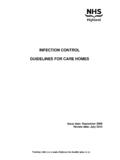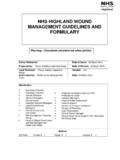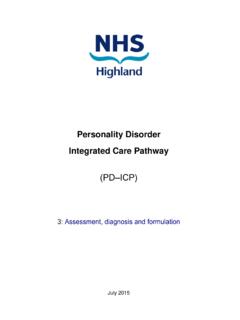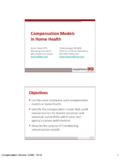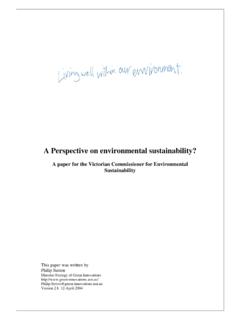Transcription of The Annual Report of the Director of Public Health …
1 The Annual Reportof the Director ofPublic Health2017 Realistic MedicineDirector of Public Health Annual Report 20172I would like to thank the following colleagues for their contributions:Core Project Group and ContributorsJane ChandlerBarry CollardCatherine FlaniganStephanie GovendenBeverley GreenSara HucFiona MacPhersonNoelle O NeillCameron StarkCathy SteerSusan VaughanAdditional contributorsIan DouglasAndrew EvennettDavid GardenSimon SteerMartin WilsonArea Clinical ForumAcknowledgements and list of contributorsDirector of Public Health Annual Report 20173 ContentsChapter One - Understanding the challenge Page 6 Chapter Two - Realistic care Page 22 Chapter Three - End of life care.
2 What it means in NHS Highland Page 30 Chapter Four - Supporting high quality end of life care Page 42 Chapter Five - Frailty and its priority in Realistic Medicine Page 48 Chapter Six - Responding to frailty Page 56 Chapter Seven - Sustainable solutions Page 66 Director of Public Health Annual Report 20174 Significant financial constraints, accelerating Health and social care demand and the impact of wider political factors on the NHS have kept Health care firmly in the Public and media spotlight1. This year s Annual Report reflects on these challenges both practically and ethically, using the framework of Realistic Medicine.
3 Last year s Annual Report focused on loneliness, recognising that 67% of people aged 65 years and over in Highland feel lonely. The Reach Out campaign linked to that Report has made significant progress in mobilising a wider societal response to this issue. A grasp of the importance of Realistic Medicine will also lead to a recognition that we have to respond to Health and social care needs as a society. The Public sector cannot meet all of society s needs and part of a realistic approach will need to include empowering communities to increasingly develop approaches to meeting their own July the 2nd 1948, when the NHS was born, it has operated on the principle of being free at point of delivery to the whole population2.
4 The NHS originated not from a legal duty to provide healthcare but from a combination of moral conviction and economic prudency3. However, prior to the commencement of the NHS, Aneurin Bevan predicted that, Expectations will always exceed capacity 4. Almost 70 years later this analysis remains accurate. As a result, we must ensure that we maximise our available capacity to provide valued, high quality care and to minimise harm, waste and unwarranted variation through personalised and innovative patient centred care. This is the core message of Realistic generosity of spirit underpinning the NHS has to be balanced against the need to allocate scarce resources as efficiently as possible. Public Health is often viewed as a utilitarian discipline, seeking to maximise the greatest good for the greatest number.
5 However, this is overly simplistic: Public Health also champions equity, recognising that unequal need requires unequal provision based on a moral duty to care for those in need. Earlier this year the Scottish Public Health Network (ScotPHN) considered what contribution Public Health could make to realising Realistic Medicine and highlighted the roles of ensuring the wise use of available evidence, empowering communities and leading and supporting innovation and implementation. All of these elements have been considered in this want to end by thanking the team who have put together this year s Report for their professionalism and commitment to the population we Hugo van WoerdenDirector of Public Health and Health Policy, NHS Highland Sti riche na Sl inte Phoblach, B rd Sl inte na G idhealtachdDirector of Public Health Annual Report 20175 Chapter One - Understanding the challengeDirector of Public Health Annual Report 20176 Why has the nomenclature of Realistic Medicine or Prudent Healthcare caught the imagination of many so effectively?
6 This chapter explores some of the drivers that have been building up over many decades and that have led to the issue coming into financial contextTotal healthcare expenditure in the United Kingdom (UK) has increased inexorably as a percentage of GDP over the last 100 years. Healthcare spend is now over 8% of gross domestic product (GDP) as shown in Figure This could rise to as much as 19% of GDP by 20611. One of the drivers for Realistic Medicine is a recognition that this trend has to be addressed if healthcare free at the point of delivery is to be societally affordable over the long - Percent of General Domestic Product for the UK spent on Health Source: is no optimum amount of expenditure on Health .
7 However, there is some evidence that each extra increment of expenditure beyond a certain point leads to diminishing returns. Many high income economies are on the part of the curve where there are diminishing returns (Figure ).Figure - Life expectancy at birth and Health spending per capita, 2011 Source: OECD Health Statistics 2013301234567891900190419081912191619201 9241928193219361940194419481952195619601 9641968197219761980198419881992199620002 004200820122016 Percent of GDPC hapter 1R = spending per capita (USD PPP)Life expectancy in yearsAUSAUTBELBRACANCHLCHNCZEDNKESTFINFR ADEUGRCHUNISLINDIDNIRLISRITAJPNKORLUXMEX NLDNZLNORPOLPRTRUSSVKSVNESPSUECHETURGB RUSAD irector of Public Health Annual Report 20177 Figure indicates that there is a relationship between spending and Health .
8 A significant proportion of the relationship is simply a reflection of the relationship between Gross Domestic Product, or the wealth of a country and life expectancy, as income is one of the most important determinants of Health . However, the graph clearly demonstrates that beyond a certain point, additional expenditure on Health provides relatively little return, and that many wealthy countries are on the part of curve. This suggests that from a realistic or prudent healthcare perspective, major additional investment in healthcare may result in relatively modest spends more per person on healthcare than the other nations of the United Kingdom (UK), although this gap is reducing over time, as healthcare spend per person in other UK jurisdictions is catching up4.
9 In 2015/16, billion was spent on Scottish Health services. The bulk of healthcare spend occurs in secondary care with more than 50% of the budget spent on hospital care and less than 10% on General Practice as shown in Figure Part of the Scottish Government s commitment is to reverse this trend and to increase the proportion of spending in primary and community care; an initiative that is very much in line with Realistic Medicine. However, this is extremely challenging in practice as the drivers in the system have been in the opposite direction for many decades. The ethos of Realistic Medicine is that providing more personalised and appropriate care will lead to better value care and as a result more efficient - Percentage of Operating Costs by Healthcare Sector 2015-2016 Source: Information Services Division (ISD), Scottish Health Service Costs5 The cost of social care In Scotland between 2004 and 2014, social care spending has seen a 15% increase in real terms for older people aged 65 and over, with 44% of the 4 billion spent in 2013/14 being on this group6.
10 Across England social care spending has also risen consistently as a percentage of national income from 1977 to 20164. However, despite the growth in expenditure, due to the rapid growth in the population aged 65 and over, there has been a 1% decrease in real terms per capita spending on social care over the decade between 2004 and 2014. Although there are also changes in where this money is spent the majority is still spent on care homes, which may not be the approach that gives the best value for money. Across Scotland, 38% of the spend on adult social care was on care homes and 25% on home care (2013/14 figures)6. There is a case for spending a greater proportion on home for Health and social care costsThe ageing population has been described as a population time bomb responsible for continuously escalating Health and social care costs.
